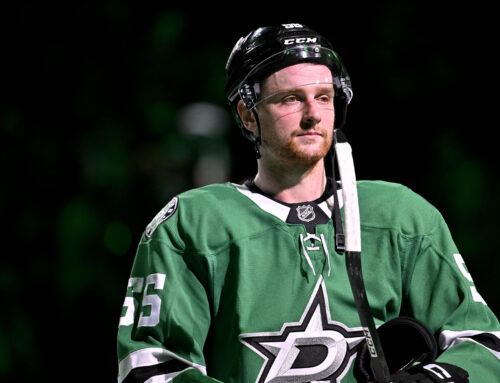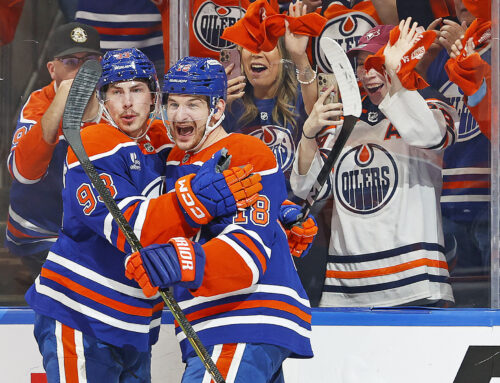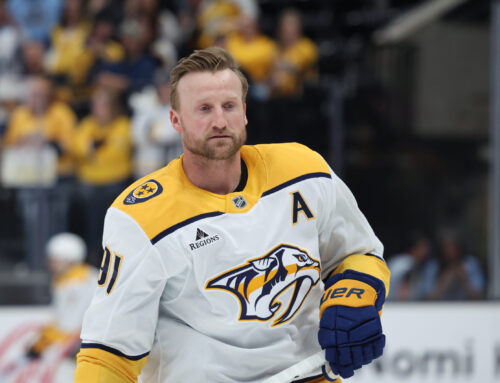Hopefully, the first annual Bubble Keeper Week helped you make some keeper decisions, or put some players on your radar for the draft. Now that we have wrapped up that event we are back for round six of our summer series, this time featuring Dallas. In addition to the Western Conference make sure you catch up on Cam’s team breakdowns in the Eastern Edge Series.
The idea for these columns to compare the end of the 2017-18 Fantasy Hockey Geek rankings for individual players with an expected ranking based on their average draft positions from the start of the year. This process does not necessarily identify who was the most important player to each team but gives us not only an idea of who was a steal/bust on draft day but where each player was valued going into this season. I will also be adding some thoughts on whether or not that is the new normal for the player in question and if we should be adjusting our draft positions.
**
* * * Pick up the 13th annual DobberHockey Fantasy Hockey Guide here (out on August 1) * * *
**
And now for the technical details. We will be using the Fantasy Hockey Geek tool to get a ranking that combines all of a player’s stats for the searched categories. Like for the previous series, the ranks are based on a 12 team, head-to-head league, using the categories of goals, assists, power play points, shots, hits and blocks for forwards/defensemen and wins, saves, save percentage and goals against average for goalies. Player eligibility for this series is based on Yahoo, and draft ranks are based on average draft positions compiled from Yahoo, ESPN and CBS by FantasyPros.
Dallas
Recap:
Dallas fell short of the playoffs in 2017-18 managing a total of 92 points, missing out on the last Wild Card spot by four points. Alexander Radulov joined the team and was definitely a success, but even with the addition of Ken Hitchcock and Ben Bishop, the goaltending wasn’t as good as it could have been.
Undervalued:
John Klingberg
2017-18 was a very successful season for Klingberg. He was the 10th ranked defensemen based on the above categories, and the 45th ranked player overall. If we look at those who were valued near him we see some pretty big names, as well as a couple who had career years.
|
Torey Krug |
BOS |
D |
36 |
|
Jeff Petry |
MTL |
D |
39 |
|
John Klingberg |
DAL |
D |
45 |
|
Erik Karlsson |
OTT |
D |
59 |
|
Morgan Rielly |
TOR |
D |
76 |
So what happened to increase Klingberg’s value? The answer is fairly straightforward. He scored more points.
|
Games Played |
Goals |
Assists |
Points |
Points/ Game |
Shots |
Sht% |
Hits |
PPlay Points |
Blocks |
|
82 |
8 |
59 |
67 |
0.82 |
204 |
3.9 |
44 |
23 |
0 |
2017-18 saw Klingberg’s highest assist, point, point per game numbers, and shots of his career, and by a pretty reasonable margin. Klingberg also saw his highest amount of power play time, the highest percentage of his team’s power play time, and his highest total time on ice. He was on the ice for about 75% of his team’s power play time, much higher than his next highest year, which was 62%. That could imply he is being used slightly differently by coach Ken Hitchcock than he has in the past. There were a couple of areas that saw a decrease for Klingberg in 2017-18. His goal totals, his shooting percentage, and team’s even strength shooting percentage were all down.
But what does all of this mean? Klingberg clearly performed better in 2017-18 than people thought he would, but can he keep it up? My short answer is yes. Higher shot, and assist numbers are accompanied by more opportunities both at even strength and on the power play. His power play numbers did not rise, but given that his overall power play time did, and his percentage of the team’s total time did, it seems like Hitchcock is going to keep giving him opportunities. The only down numbers really aren’t negatives at all. His goal numbers are down due to a low (for Klingberg) shooting percentage. He actually increased his total shots so if he had a more reasonably shooting percentage (say his career average of 6%) he would have added four goals to his totals and would have broken 70 points. The only actual red flag is that his IPP was quite a bit higher (at 54%) than his career numbers (about 42%). That could mean he got a bit lucky, or he had a higher percentage because of power play time, or the different playing style meant he was more involved in the offense.
In summary: it could be that a new style of play from Hitchcock might mean we expect a lower shooting percentage from Klingberg, but it is also possible that it means he is more involved in the offense and getting those assists. It might be that Klingberg saw a few too many assists this year and those will drop off slightly, but his shooting percentage will improve, resulting in more goals. It is hard to know exactly which will be the case but overall I say that a 65ish point Klingberg can definitely be a new normal.
Alex Radulov
In his first season as a Star, Alex Radulov definitely impressed. If we take a look at the table below, he is ranked among some pretty impressive company for 2017-18. He was the ninth most valuable dedicated (i.e. not centre eligible) winger over the course of the season. Those wingers around him have an average draft position of 64, while Radulov was taken 90th overall.
|
David Pastrnak |
BOS |
ATL |
RW |
38 |
|
Jakub Voracek |
PHI |
MET |
RW |
49 |
|
Alexander Radulov |
DAL |
CTR |
RW |
65 |
|
Brad Marchand |
BOS |
ATL |
LW |
69 |
|
Anders Lee |
NYI |
MET |
LW |
82 |
Radulov had a decent year in 2016-17 with Montreal, but it is clear that a change of scenery did him a lot of good. Every scored stat, and most of the underlying numbers increased after his transition to Dallas.
|
Games Played |
Goals |
Assists
📢 advertisement:
|
Points |
Points/ Game |
Shots |
Sht% |
Hits |
PPlay Points |
Blocks |
|
82 |
27 |
45 |
72 |
0.88 |
217 |
12.4 |
77 |
23 |
0 |
I honestly do not think a lot of analysis is needed here. He played in more games, saw more time on ice, more power play time, and played with better linemates. This all resulted in an increase in production across the board.
His personal shooting percentage, IPP, and team even strength shooting percentage were all remarkably consistent between his Montreal and Dallas years. All of that says to me that everything he is doing is sustainable, and we had better adjust our draft positions accordingly.
Overvalued:
Jason Spezza
When folks drafted Jason Spezza in 2017-18 I am sure they were hoping that 16-17 was a deviation and that he would return to his recent 65 point self. There was even some optimism that Radulov would add a winger to the mix that might be a jolt of energy for the ageing Spezza. Man. It did not work out.
Spezza finished the season as the 484th most valuable player in the league and is the only one of the players shown below to be drafted (not being drafted correlates roughly to a position of 350+). Spezza was drafted 163rd overall.
|
Zemgus Girgensons |
BUF |
ATL |
C/LW |
465 |
|
Zack Smith |
OTT |
ATL |
C/LW |
473 |
|
Jason Spezza |
DAL |
CTR |
C/RW |
484 |
|
Derek MacKenzie |
FLA |
ATL |
C/LW |
495 |
|
Jared McCann |
FLA |
ATL |
C/LW |
511 |
I am tempted to dig into the what-went-wrong question, but I think a more reasonable task might be to find something that went right.
|
Games Played |
Goals |
Assists |
Points |
Points/ Game |
Shots |
Sht% |
Hits |
PPlay Points |
Blocks |
|
78 |
8 |
18 |
26 |
0.33 |
138 |
5.8 |
16 |
11 |
0 |
Spezza still saw two minutes a night on the power play sometimes on the first unit and managed 11 power play points. That’s about it.
Spezza saw his lowest (and often by a large margin) goal, assist, point, shot, power play point, power play time on ice, total time on ice, shooting percentage, IPP, and team five on five shooting percentage of his career. Just one note of emphasis here, Spezza has just been absolutely shedding time on ice since 2011-12 where he was seeing 20 minutes a night. It has dropped every year and in 2017-18 where he is down to 13. Towards the end of season, he was even seeing as few as nine (!!) minutes. Oh, and he is also 35.
Going forward I just don’t have much optimism. It is possible that his IPP, personal shooting percentage and team even strength shooting percentage indicates that he got some (like a lot of) bad luck last year. If we are generous and give him his average shooting percentage and better puck luck in his other stats and he could conceivably add 15 points to his total. That would mean we are looking at a 41 point season. Better, but still not draftable in many leagues. It is also possible (and likely) that getting back to those career averages is going to be harder and harder as he goes into his age-35 season and is getting a max of 13 minutes a night. So yes maybe 2018-19 won’t be as bad as 2017-18, but at this point in his career, I am certain there are other players whose apparent ceilings are higher than a half point per game.
Julius Honka, Antoine Roussel, Martin Hanzal
I am not going to go in depth on these three, as they are much deeper adds, but it is worth a note that they all underperformed their draft position significantly. That feat is slightly more impressive given that none of them were typically drafted in in leagues featuring less than 250 players.
Thanks for reading.
Next week: Edmonton
Recent Articles
Wild West Summer Series: Arizona
Wild West Summer Series: Anaheim
Wild West Summer Series: Calgary
Wild West Summer Series: Chicago
Wild West Summer Series: Colorado






 FLA
FLA EDM
EDM NYR
NYR CGY
CGY MIN
MIN SEA
SEA OTT
OTT
